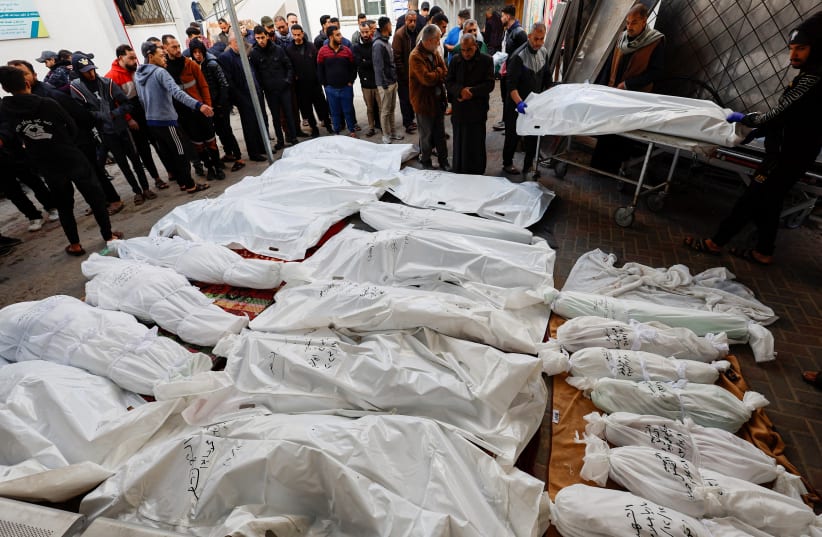Amid the ongoing war in Gaza, the calculation and reporting of Palestinian civilian casualties there have sparked intense debate by researchers and activists from both sides. Adding to the already complex situation, the UN Office for the Coordination of Humanitarian Affairs (OCHA) has announced a significant revision to the numbers published previously. This revision, which cuts the original number of women and children in Gaza “identified” as deceased by more than half, has prompted questions about the general accuracy and transparency of casualty data until now.
Until May 6, OCHA had reported a death toll of over 34,000 from the conflict. The Hamas-controlled Government Media Office (GMO) in Gaza claimed that 27% of the fatalities were women and 42% children.
The UN agency released revised figures on May 8, stating that only 24,686 deaths could be specifically identified (or confirmed). According to OCHA, among the deceased, 20% were women and 32% were children. This revision indicates a reduction in the reported number of women and children killed in Gaza since October 7 by 52% and 53%, respectively
Hamas Health Ministry
According to UN spokesperson Eri Kaneko, who explained this change to The Media Line, “The overall number of fatalities tallied by the Ministry of Health in Gaza remain unchanged, at more than 35,000 people since October 7. However, the ministry has updated the breakdown of fatalities for whom full details have been documented. The Ministry of Health recently published that breakdown for 24,686 out of the 34,622 fatalities recorded in Gaza as of April 30.”
Kaneko said that despite Israel accusing the Hamas-run Health Ministry of inflating numbers to cause global public outrage against the Jewish state, using numbers provided by Hamas-controlled public organizations is the international standard when the UN cannot verify the death toll independently and there are local health authorities.
“According to the ministry, the fatalities for whom full details have been documented include 7,797 children, 4,959 women, 1,924 elderly, and 10,006 men. The ministry notes that the documentation process of casualties’ full identification details is ongoing,” she continued.
“United Nations teams in Gaza are unable to independently verify these figures, given the prevailing situation on the ground and the sheer number of fatalities. For this reason, all figures used by the UN clearly cite the Ministry of Health in Gaza as the source. The UN will verify these figures to the extent possible when conditions permit. In the absence of complete UN figures on casualties, it is the global standard to cite the local health authorities as appropriate,” Kaneko concluded.
Questioning the accuracy of the UN’s numbers, researcher Gabriel Epstein from the Washington Institute for Near East Policy, a pro-Israel think tank based in the American capital, told The Media Line, “OCHA does not actually calculate either the death toll or injury figures, and they have not made any attempts to do real-time monitoring or verification of the numbers of dead, or tentative identification of civilians and militants, as they have done in prior rounds of conflict.”
Epstein noted that the UN agency was transparent about its data limitations, stating a disclaimer in each report that it had " not been able to produce independent, comprehensive, and verified casualty figures" and that “the current numbers are provided by the Ministry of Health in Gaza, the GMO, and Israeli authorities, awaiting further verification, and that “other yet-to-be verified figures are also sourced.”
But May 13, 2024, the disclaimer was updated to include: "Previous data breakdowns provided in this snapshot of women and children killed were attributed to the GMO based on reported fatalities. The fatality breakdowns currently cited are those that the Ministry of Health in Gaza has recently fully identified out of the higher number of casualties they report."
Epstein emphasized that OCHA republishes claims from Hamas' Ministry of Health or GMO without verification, including combatant casualties in its reports. The issue is compounded by OCHA's inconsistent use of data from the Ministry of Health and the GMO without explanation.
"Put simply, OCHA shifted from using GMO reporting to using the Ministry of Health reporting," Epstein explained. This switch resulted in a sharp revision of figures, categorizing 25,000 as “identified” dead and 10,000 as “unidentified” dead—both names Epstein finds misleading.
“The Ministry of Health stopped reporting entirely between November 10 and December 2, and OCHA began sourcing GMO figures on November 22, saying only that the GMO’s ‘methodology is unknown.’ The GMO is a unit of the Hamas-run Ministry of Information, and there is no evidence that it has any ability or authority to collect casualty data. The Ministry of Health is the only health authority in the Strip with that capacity,” he asserted.
Epstein explained that beginning December 11, the Ministry of Health in Gaza released detailed casualty reports from hospitals and included deaths and injuries sourced from "reliable media sources." However, OCHA only began listing these hospital/morgue system deaths and the total from media reports on May 8. Since April 1, the Ministry of Health has categorized these media-sourced deaths as "unidentified," but they are merely rebranded media accounts.
“OCHA did not cite any subtotals for women and children in its reporting between January 3 and March 7, then the UN agency returned to reporting GMO subtotals on March 8 and continued to do so until May 8, when it reverted to reporting Hamas’ Ministry of Health subtotals for the first time since November 10, 2023,” summarized the policy researcher.
GMO figures, Epstein said, have always conflicted with Ministry of Health data. On December 11, the Ministry reported 5,577 men killed according to the hospital/morgue system, while the GMO claimed 18,396 total deaths, including 8,000 children and 4,200 women, leaving a maximum of 4,196 men. "To reconcile the GMO claims with the available Ministry of Health data, 1,381 men would need to come back to life," Epstein said.
Epstein noted that the gaps between Ministry of Health data and GMO claims continue. On May 3, ministry data showed 10,008 men killed, while GMO claims indicated a maximum of 9,829 men, meaning "179 men would have to come back to life to reconcile the GMO and the Ministry of Health." He criticized OCHA for returning to GMO claims in March, saying they are pretending the Ministry's data just became available when it has been consistently updated since mid-December.
The Ministry of Health uses three primary sources to calculate its death toll reports, Epstein explained. “The first is the hospital/morgue system that identified victims, cataloged the data, and uploaded to a central database. This is the system in place in peacetime and in all previous conflicts. It’s considered relatively robust, particularly given Gaza’s overall low level of development. This methodology currently accounts for roughly 60% of the reported deaths in Gaza,” he added.
“The second method is self-reporting via a Google Form by relatives of the deceased and missing. This methodology was introduced on January 5, and the first tranche of data collected via the form was released on April 1. This methodology currently accounts for roughly 10% of reported deaths,” Epstein continued.
Epstein explained that the most problematic source for Hamas' Ministry of Health is reports from "reliable media sources." Disclosed on December 11 in an Arabic-language PDF on the Ministry of Health Telegram channel, this methodology likely began on November 3, soon after the IDF’s ground invasion. "No further details have been given regarding this methodology, and no data from it has ever been released. This methodology, which the Ministry of Health rebranded as 'unidentified' deaths on April 1, accounts for roughly 30% of all reported deaths," Epstein concluded.
Most online sources have not updated their statistics to reflect the new data, which reduced the number of dead children and women in Gaza by more than half. For instance, Wikipedia's main article on the Israel–Hamas war still claims over 35,000 Palestinians killed, including over 15,000 children and 10,000 women. However, the updated OCHA data reports 4,959 women and 7,797 children killed and introduces the category of "unidentified" deaths.
Speaking in a recent interview, Israeli Prime Minister Benjamin Netanyahu reiterated his stance on the civilian toll, asserting that around 30,000 people have died in Gaza, with Hamas fighters comprising nearly half of that number. He said Israel was making efforts to reduce civilian casualties while pursuing its legitimate military goals under difficult circumstances, and estimated that around 14,000 combatants and 16,000 civilians had been killed.

